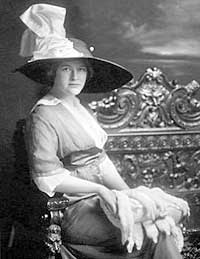Margery Boot’s canteen
By Judith Wright, Archivist, Boots UK

Margery Amy Boot was the youngest daughter of Jesse and Florence Boot (of Boots the Chemists). She was born in 1892 at Snig Hill in Sheffield, but grew up in Nottingham. During the First World War, Margery established a refreshment centre for sick and injured soldiers in northern France. She raised the money from donations. Boots staff magazine at the time, Comrades in Khaki, recorded the following in April 1915:
“… we must, each and all of us, feel a glow of pride in the fact that one of the most urgent needs has been provided for by Miss Margery Boot, the younger daughter of our Chief. This lady’s work lies in northern France and its value and extent cannot be over-estimated. The journey of the wounded soldiers from the field to the base hospitals on the French coast is inevitably one of great hardship and severe discomfort … and it was a high-minded womanly inspiration that led Miss Boot to establish a kitchen and café at one of the principal railway junctions to succour those so greatly in need of kindly ministration. As soon as the project was brought forward its merit was widely acclaimed. The French military authorities, the British Red Cross Association, medical men, soldier men, in fact every one best qualified to judge, warmly endorsed this proposal; and encouraged by this consensus of favourable opinion, Miss Boot proceeded to give practical effect to the scheme. her first requirement was assistants, with some of her own pluck and capacity for personal service – she got them. Next she needed money and provisions – she got them. Then on December 28th she left for France, where she is still carrying on the good work.
Lady Samaritans at the café render to the sick and wounded men those delicate little attentions that mean so much and they provide comforts in the way of warm nourishing food with cocoa, tea, coffee, milk etc. It requires no great imagination to appraise in some measure the value of this mission. Many a long train brings wounded men to the junction. They are tired, disconsolate, fretful through pain and worn by hardship and the helping hand performs an act of truest mercy. It is worthy of note that among the first contributories to the fund raised by Miss Boot were the Crimean and Indian War veterans at the Dorothy Boot Homes in Wilford. These old souls gave of their scanty means to a cause whose worth they understood so well. Whoever wishes to follow their example will find gifts of money, provision, etc. gratefully received by Lady Boot.”
This letter follows, from Driver Alfred E Carr: “I was very pleased to read in your letter that your concert for the funds of Miss Boot’s coffee stalls was such a success. I feel immense gratitude myself, as three boys in my own section actually received the benefit of these arrangements. The coffee came just at a most thirsty and trying part of our journey. All the boys were just then short of tobacco and cigarettes owing to not having received any pay for the last few weeks. You can imagine our enjoyment and appreciation. It put us all in a very amiable mood.”
The next edition of Comrades in Khaki, May and June 1915, praises the value of her work, and mentions that her canteen helped 47,769 soldiers up to the middle of April. It refers to the necessity for the canteen to move locations and feeding 5,170 wounded soldiers within the first seven days of being in the new facility. A fully trained nurse was also in attendance, always ready to change a dressing or bandage and a call was sent out requesting socks to clothe the feet of the endless stream of bare foot men who came through the doors.
Unfortunately, Comrades in Khaki ceased publication in May 1916 due to shortages in both paper and the labour market, so no further information is available. However, Margery’s benevolence did not end there. After marrying in 1921 and having three children, she opened Dedisham Convalescent Nursery School with her husband in 1929. Margery served as the Vice-President, along with the Duchess of Norfolk, the President. The school was run for ‘the benefit of delicate children up to seven years of age, who could not otherwise have a long period in country surroundings and have a chance of being restored to normal health’. Margery was personally involved with aspects of the day to day running of the Convalescent Nursery, for example, ‘the sun-giving aspect, the simple and charming furnishings in which are lovingly printed linens in delightful colourings and design touching on “the Wind in the Willows” story which adorn the screen covers, window curtains, bedcovers, etc.; this scheme, brought into practice and inspired by the Hon. Mrs. A. M. Holman, and which includes an emblem allocated to each child, for example, Peter Rabbit, Jemima Puddle Duck. etc. All the children have their emblem worked on all clothing, towels etc., and therefore know what is theirs without a doubt’.
Margery died aged 95 in 1987, at her home in Jersey.